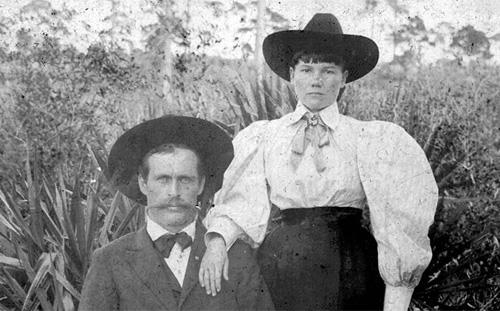
The three lives of Laura Ingalls Wilder continue to fascinate us.
There was young Laura, growing up in little houses on prairies. Many girls try to replicate that life.
"They are dressed in their little gingham outfits," Mary McDonagh Murphy, producer of a new American Masters portrait, Laura Ingalls Wilder: Prairie to Page, at 8 p.m. ET, Tuesday, on PBS (check local listings), told the Television Critics Association (TCA) in July. "They come on these pilgrimages because they feel they know her."
And there was older Laura, who was 65 when her first novel was published. Seven more followed, and she had 25 years of fame.
"Wilder transformed her frontier childhood into the best-selling Little House series and helped shape American ideas," said Masters producer Michael Kantor.
But what about the Laura in between? What about the first 47 years of her marriage to Almanzo Wilder (top, with Laura), before she became famous?
Those were rugged decades, Murphy said. "He had diphtheria; their house burned down." Their baby died, and their barn burned, destroying a harvest. "They (kept) trying to make ends meet."
That links her life to our pandemic era, Murphy said. "When I think about what any of us have been through in the test of our pioneer spirits lately, what she endured was really remarkable."
Still, modern kids seem to envy her. Laura – the semi-fictional character in the books and the Little House on the Prairie TV series – shares traits with other popular young heroines.
She's a tomboy – something she shares with Jo in Little Women and Anne in Anne of Green Gables. And she's close to her dad, something she shares with Scout in To Kill a Mockingbird.
"She has a fabulous relationship with her father," Murphy said. "This has been said of Atticus Finch (Scout's dad), too, but everybody wants a father like Pa. Most people don't have one."
The real Pa Ingalls faced many problems. Twice, he had great crops that were destroyed by locusts. He often moved, about fifteen times in Laura's childhood, once in the middle of the night, to flee debts.
But he was a vibrant soul, a fiddler, and a storyteller. Then he gave Laura a storytelling duty.
She was 12 at the time that her sister Mary, 14, lost her eyesight.
"Pa says, 'It's on you now, Laura; you need to show her what's what and tell her,'" Murphy said. "I think that is a huge, huge factor in how she became a writer and her descriptive powers."
Those powers would be dormant for more than two decades. But in her 40s, Wilder became a columnist for Missouri farm magazines.
The successful writer was her daughter, Rose Wilder Lane. That part of the story is told by Pamela Smith Hill – a little in the PBS film and at length in the prelude to Pioneer Girl, the Wilder manuscript that the South Dakota Historical Society Press published in 2014.
Rose had seven books published and was making top-dollar from magazines. After a divorce, she moved back to the family homestead in Missouri, building a new house for her parents. Then the Depression hit. "God! I need money," she wrote in her journal in 1930. "Dreamed a worry all night."
Lane often edited top authors, Hill wrote, but now she edited Prairie Girl, her mother's long, first-person account. "Working on my mother's story – stupidly, for nothing will come of it," she wrote.
Publishers rejected it, and Wilder offered to rewrite some of the tales, aiming them at kids. Lane dismissed that. "There is no opportunity to make a name with children's stories," she wrote.
But that's just what Wilder did. Rewriting the stories for young readers, she became one of the world's best-known authors. Rose had reshaped and heavily edited them, but the observations – and the experiences they fictionalized – were Laura's.
"I realized that I had seen and lived" all the phases, she told a Detroit Book Fair audience in 1937. "First the frontiersman, then the pioneer, then the farmers and the towns…. In my own life, I represented a whole period in American history."
Parts of that era no longer reflect our values. "In the entire body of her work," Murphy said, "we are talking about five-to-eight racist scenes, particularly with respect to Native Americans.
There is one scene of Pa in blackface. What we tried to do…is show you that historical context."
The pioneer spirit shaped Wilder's own views. "She had fairly firm anti-government, anti-New Deal sentiment," Murphy said, but it was Rose "who kind of became the libertarian rock star."
When Lane died (in 1968, at 81), the Masters film says, The New York Times obituary didn't mention that she had a famous mother. Decades later, people would realize how much she had helped shape her mother's life-changing work.